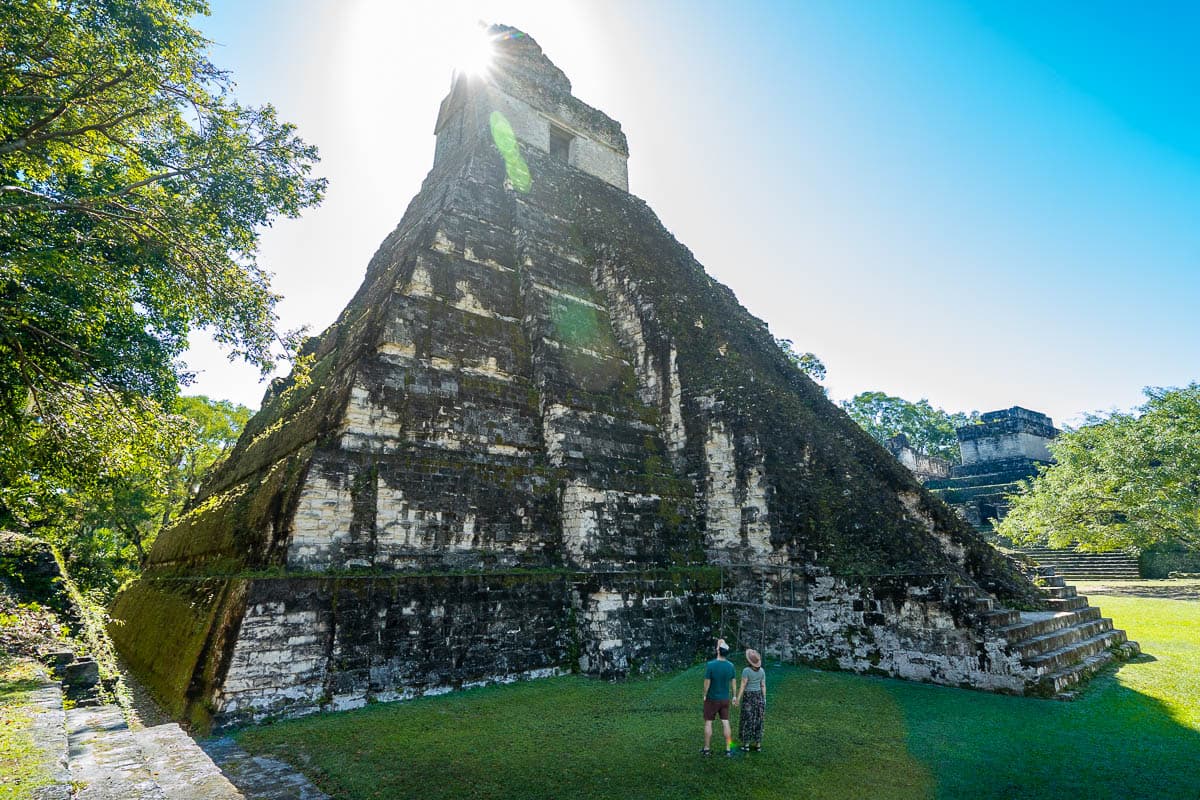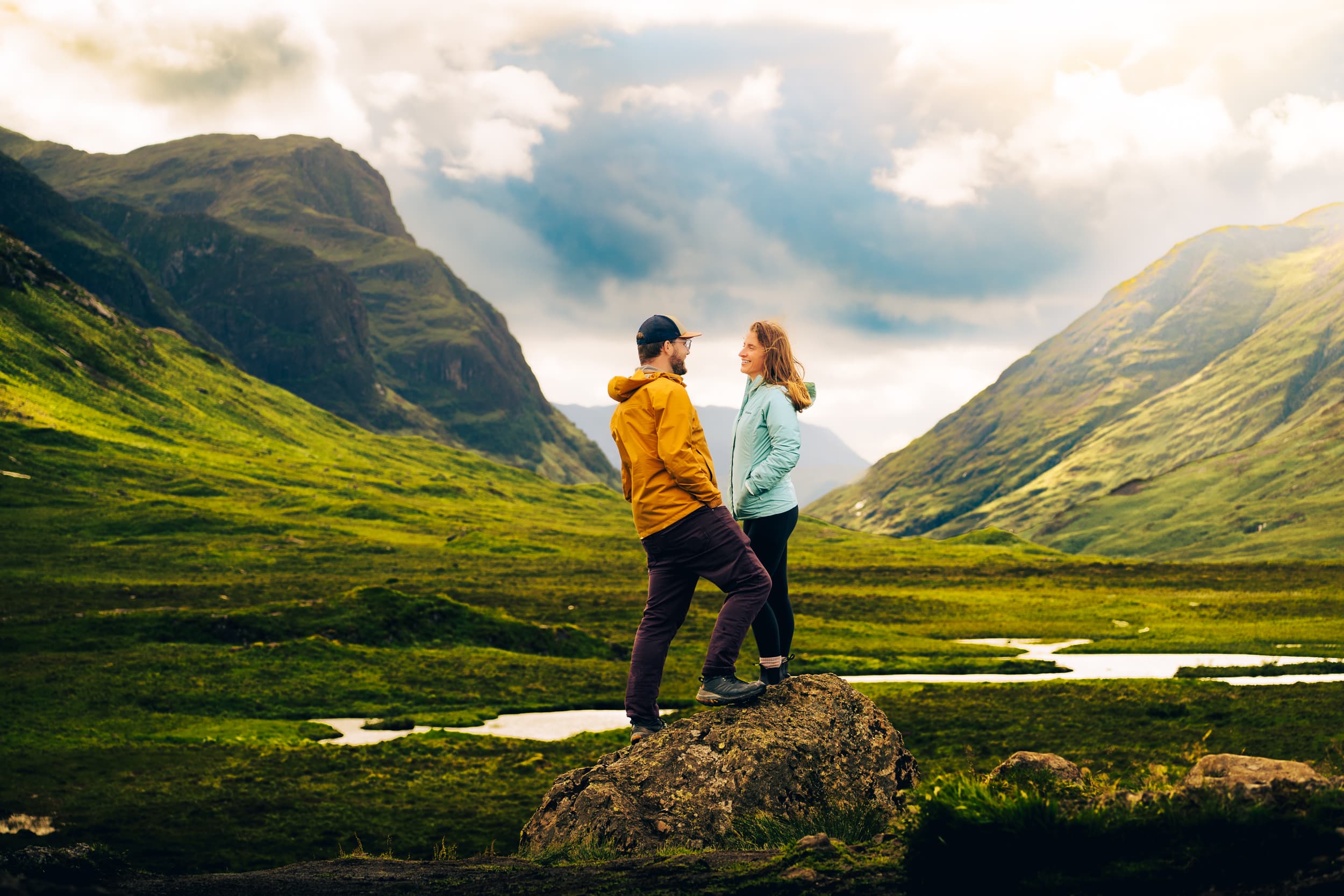The ancient Mayan ruins of Tikal is one of the most popular stops in Guatemala for visitors—and for good reason! Dating all the way back to 1000 BC, exploring this UNESCO World Heritage Site kind of makes you feel like you’re Indiana Jones—in fact, you can even climb some of the temples here!
While visiting Tikal is definitely bucket list worthy, it also can be a bit confusing at times, from whether you need a guide and where to buy tickets to where to stay while you’re visiting the park and what’s actually worth exploring at the enormous site. My husband, Justin, and I recently spent almost a month exploring Guatemala, including these beautiful ruins, and have put together this guide with everything you need to know about visiting Tikal.
This post may contain affiliate links. If you make a purchase through them, we may receive a small commission, for which we are extremely grateful, at no extra cost to you.
What is Tikal?
Tikal National Park, located in the Peten region of northern Guatemala, was built up to three thousand years ago.
However, it eventually became one of the most important cities in the Mayan civilization sometime between 600-900 AD, thanks to its central location along the Mayan trade network. At its peak, it’s estimated that Tikal had a whopping 90,000 residents.
It’s believed that Tikal was abandoned by the Mayans rather suddenly in the 10th century, possibly due to overpopulation and drought, and remained unknown to the outside world for almost a millennium. Local people, though, never forgot about the mighty city and actually guided the first expedition to the ruins, executed by the Guatemalan government, in 1848.
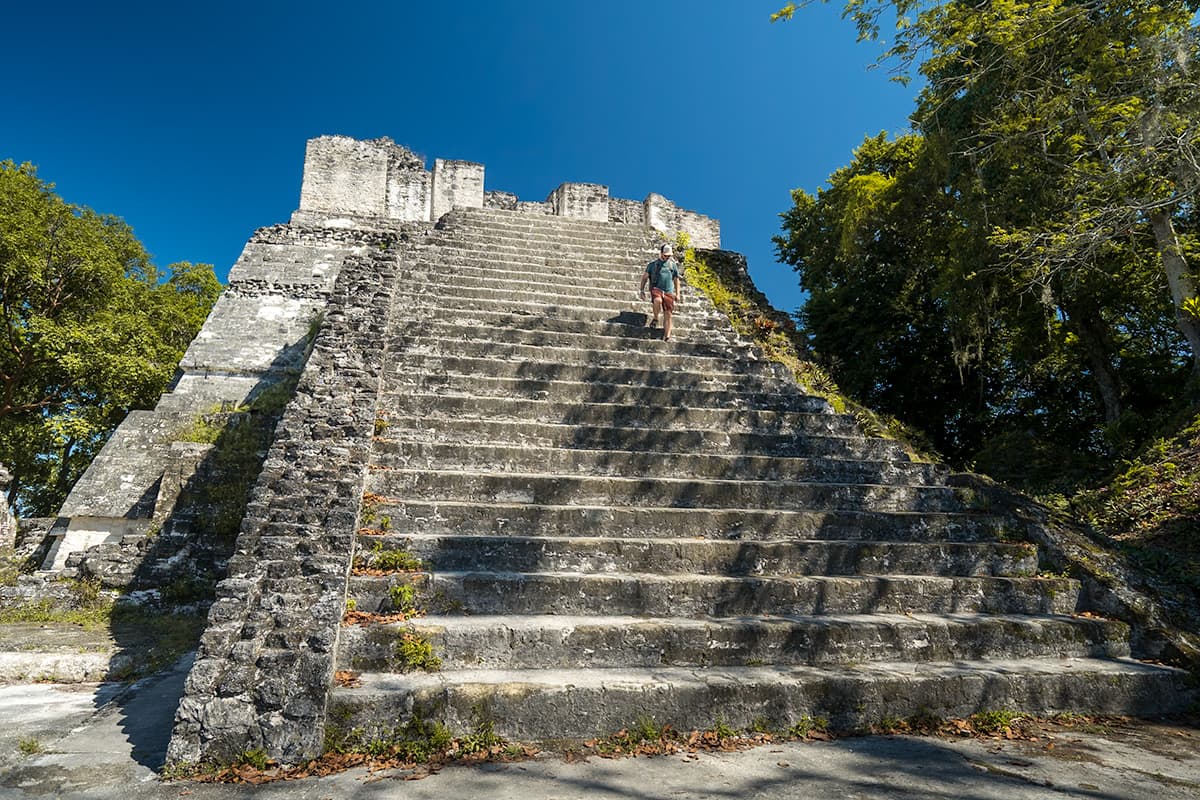
Since then, Tikal has become a popular attraction for history lovers and adventure seekers and was declared a UNESCO World Heritage Site in 1979.
In fact, it became so renowned for its otherworldly beauty that it was even featured as a Rebel base in Star Wars: A New Hope (if there are any fellow nerds out there, you should head to Temple IV in Tikal to see the filming location for yourself!).
How to get to Tikal
Most visitors get to Tikal from the colorful Mayan town of Flores on Lake Peten, which is located about an hour and 15 minutes south of the ruins.
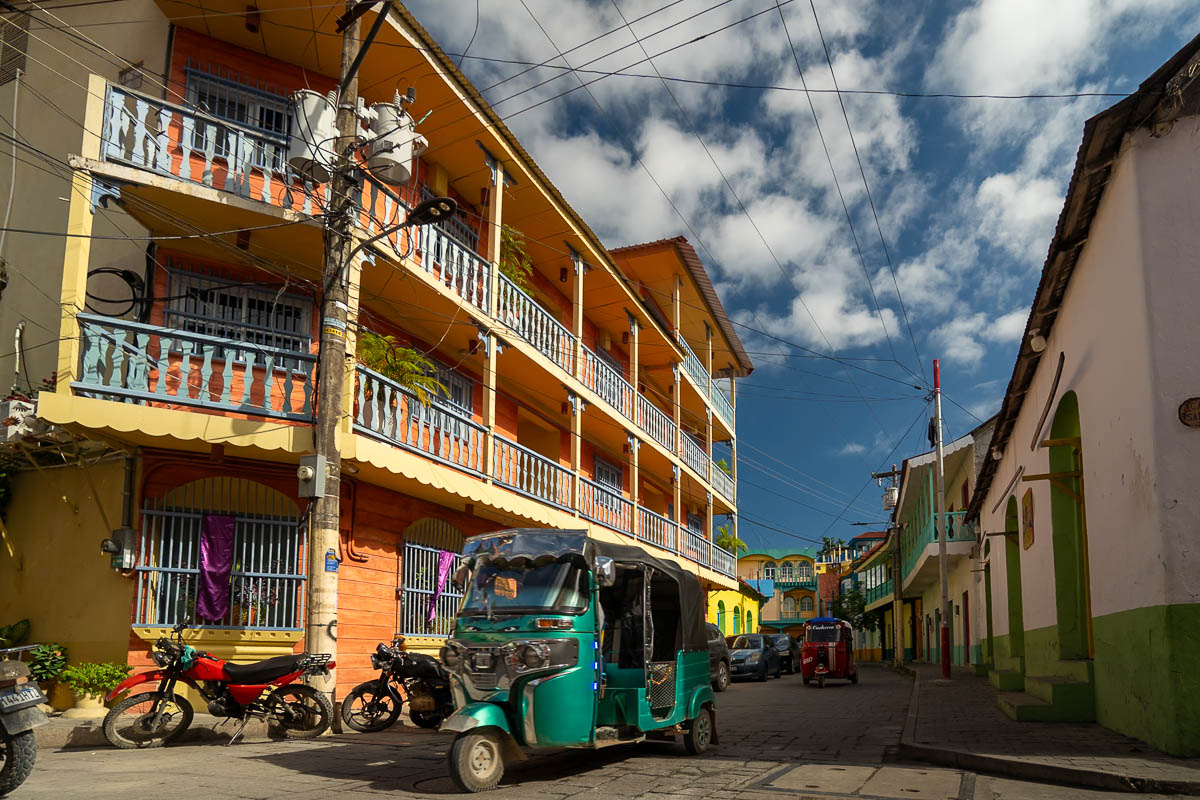
There’s a few ways that you can get from Flores to Tikal.
Taking a tour
The most popular way that most visitors get to Tikal is by taking a tour from Flores.
Going with a tour has some major benefits—for one, transportation is totally taken care of for you and, for another, you’ll have a knowledgeable guide that will help provide additional context and history about the impressive civilization that once called this place home. Plus, the guides are INCREDIBLY impressive at spotting wildlife in the dense treetops above.
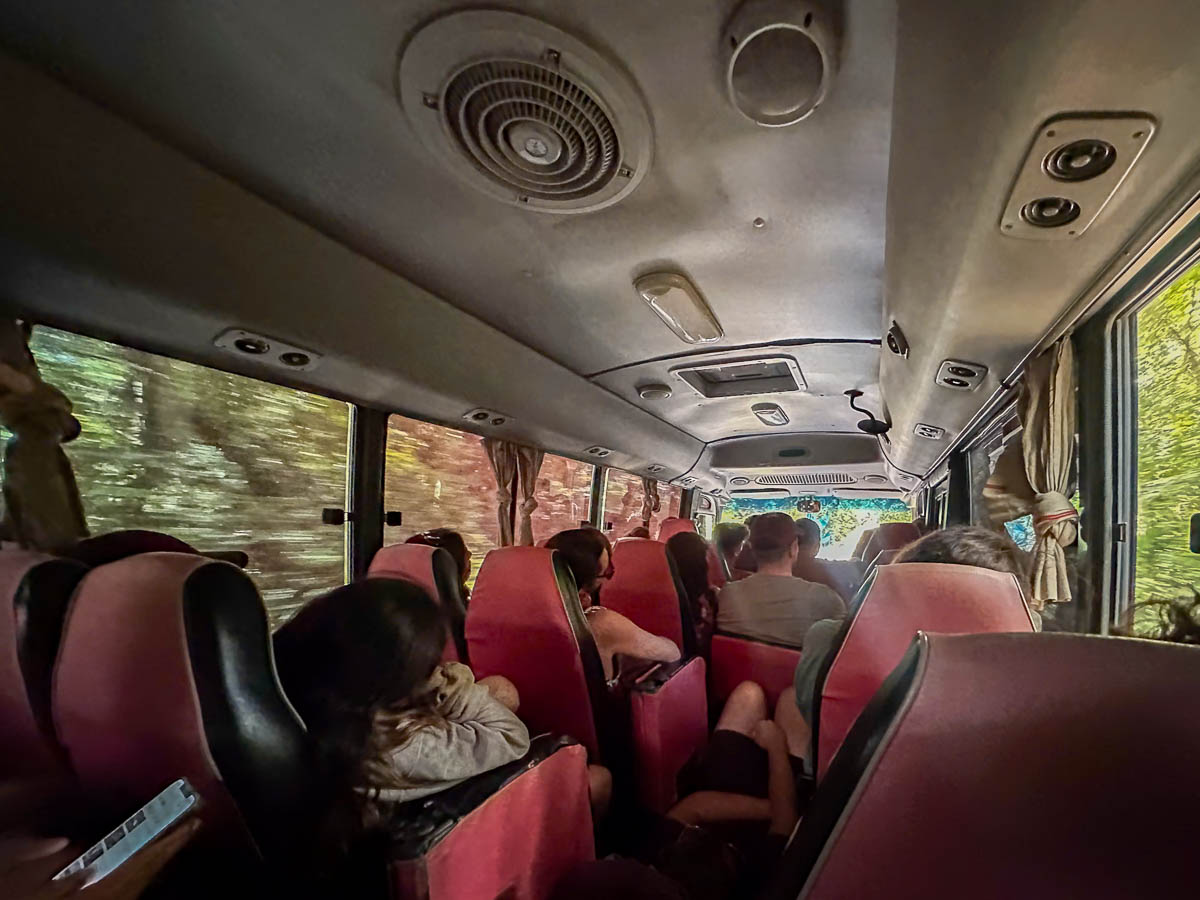
Tours to Tikal depart from Flores throughout the day, leaving as early as 2:30 AM for sunrise or as late as 12 PM for sunset.
If you have a day or two in Flores before your visit to Tikal, it’s easy to stroll around its streets and pop into one of the many operators that offer tours. Just be sure to only buy tours from agencies with actual storefronts—we’ve heard there are various scams of hustlers on the streets or buses around Flores, selling fake tickets to Tikal.
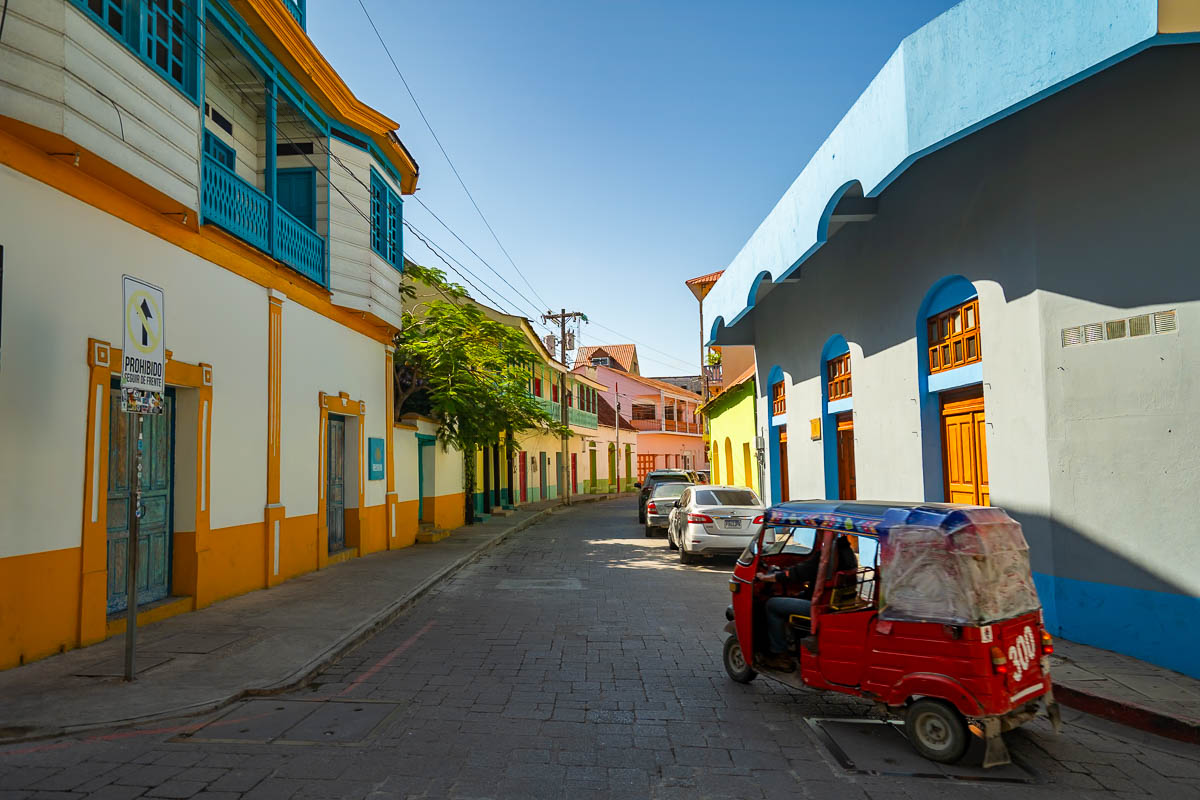
Alternatively, if you’re short on time or just prefer to have activities arranged ahead of time (*sheepishly raises hand*), you can alternatively sign up for a tour online ahead of time, such as:
Just be aware that the cost of most tours, whether purchased at an agency or online, only include the transportation, guide, and, depending on which tour you choose, sometimes breakfast or lunch. It rarely includes the cost of admission to Tikal itself.
Taking public transport to Tikal
If you’re on a tighter budget and don’t mind a longer ride to Tikal, you can alternatively take a collectivo from the bus terminal of the neighboring town of Santa Elena for about 50Q each way.
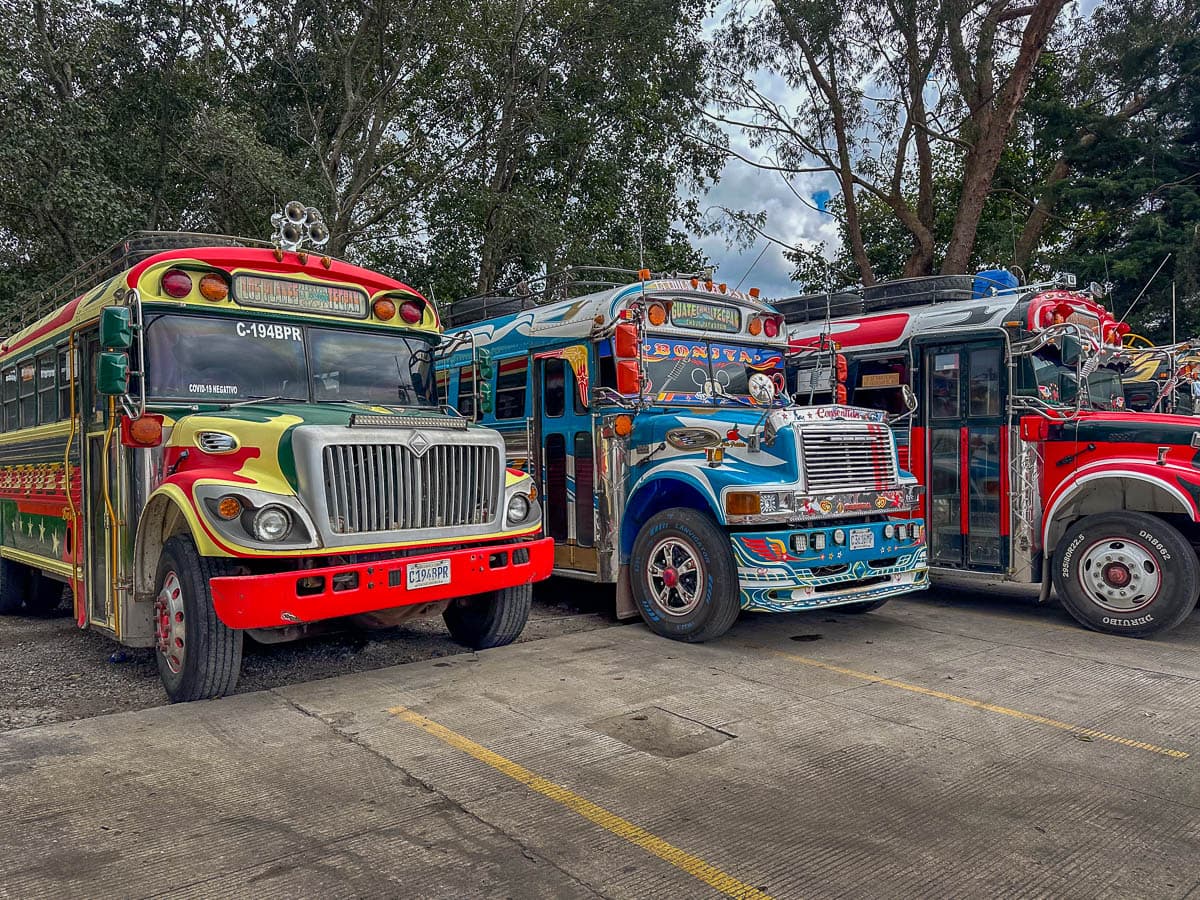
They depart about every two hours, starting at 6:00 AM and go all the way to the entrance of Tikal. While it’s cheaper than riding one of the tour shuttles, it’s also decidedly more uncomfortable—there’s no air conditioning, they are usually quite crowded, and there’s quite a few stops along the way.
How Much Does It Cost to Visit Tikal?
For visitors who do not have a Guatemalan ID, it costs 150Q (or about $20 USD) to enter Tikal from 6 AM to 5 PM.
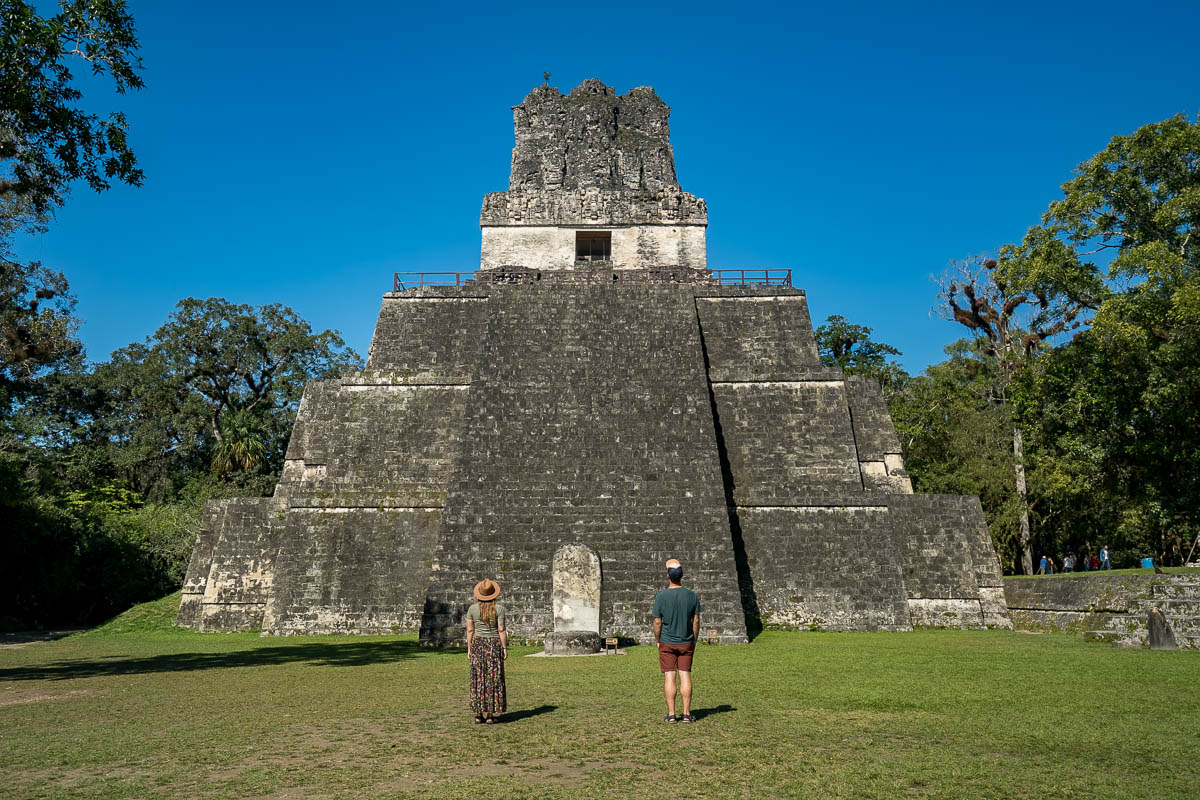
There’s also an additional 100Q charge if you want to visit the park either for sunrise (i.e., before 6 AM) or sunset (after 5 PM). It’s also worth noting that you can only visit Tikal at sunrise or sunset with a guide.
How to Buy Tickets for Tikal
There are a few ways that you can purchase tickets for Tikal. Regardless of how you purchase your tickets, you can buy them for up to a month before your visit.
At the Tikal Ticket Office
You can conveniently purchase tickets directly at Tikal.
This actually isn’t the most convenient option, though, given that the ticket office is located 17 kilometers away from the park’s entrance. Additionally, you must bring enough Quetzals—the ticket office is cash only.
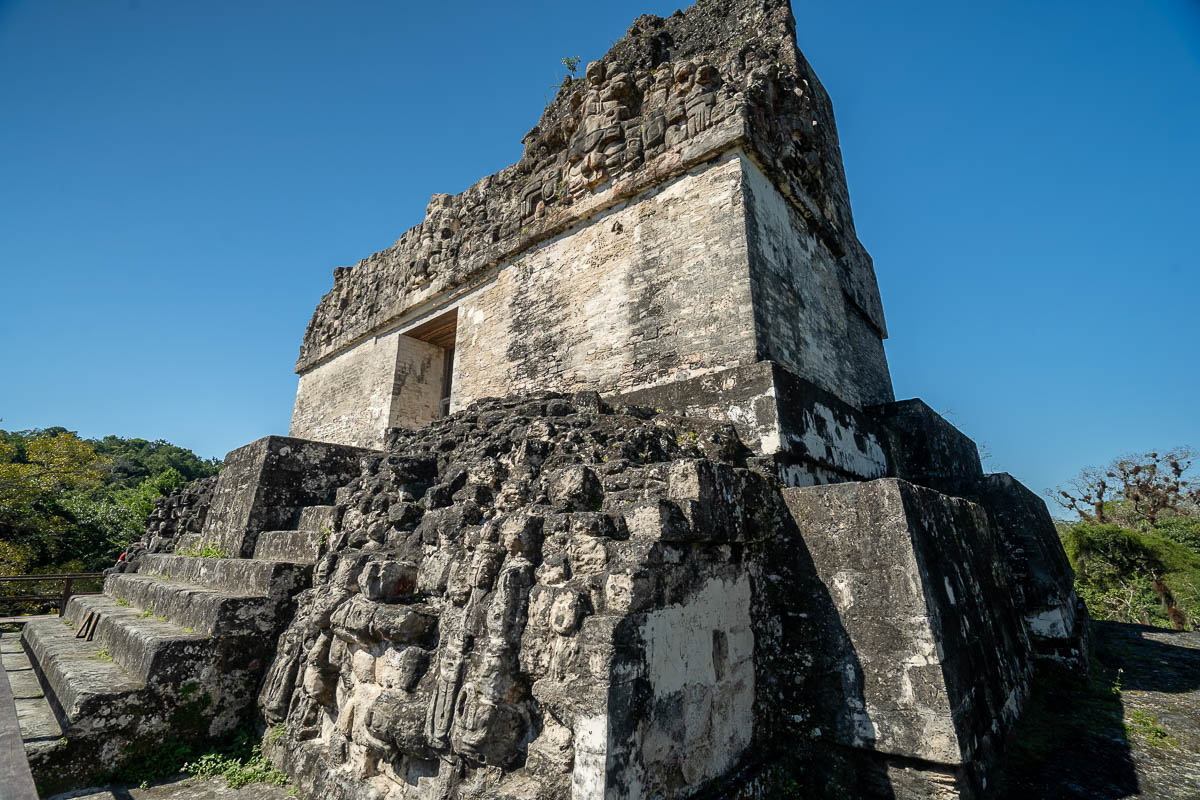
If you’re visiting with a tour group, most of them will stop at the ticket office on your way to the park so you can pick one up. Just be sure to confirm this with your operator ahead of time whether they’ll be stopping here—a handful of tours will purchase tickets for you ahead of time or alternatively, will expect that you purchase your ticket before you get to the park.
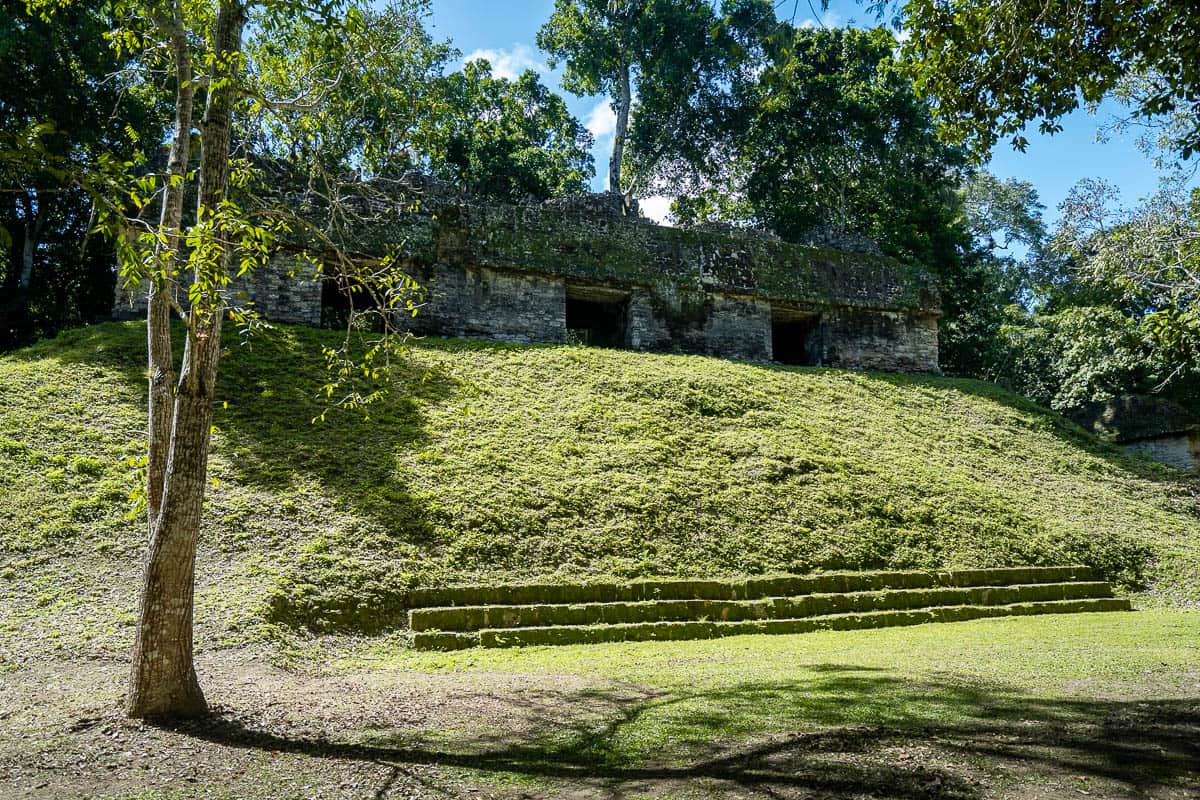
Purchasing tickets onsite won’t work for all visitors, though.
For example, most public transit will not stop at the office and wait for you to purchase tickets at the office. Additionally, the ticket office is open from 7 AM to 5:30 PM—so if you’re planning on visiting for sunrise, you cannot purchase tickets on site during the day of your visit.
Insider tip: You may read online that, if you purchase tickets after 3 PM on the day of, they’re also good for admission on the following day. This is no longer accurate—tickets are only good for the day they’re purchased.
At Banrural Locations
You can also purchase Tikal tickets at Banrural locations, a popular bank around Guatemala. Banrural has branches all over the country, including in Guatemala City, Antigua, and Santa Elena, the town that neighbors Flores.
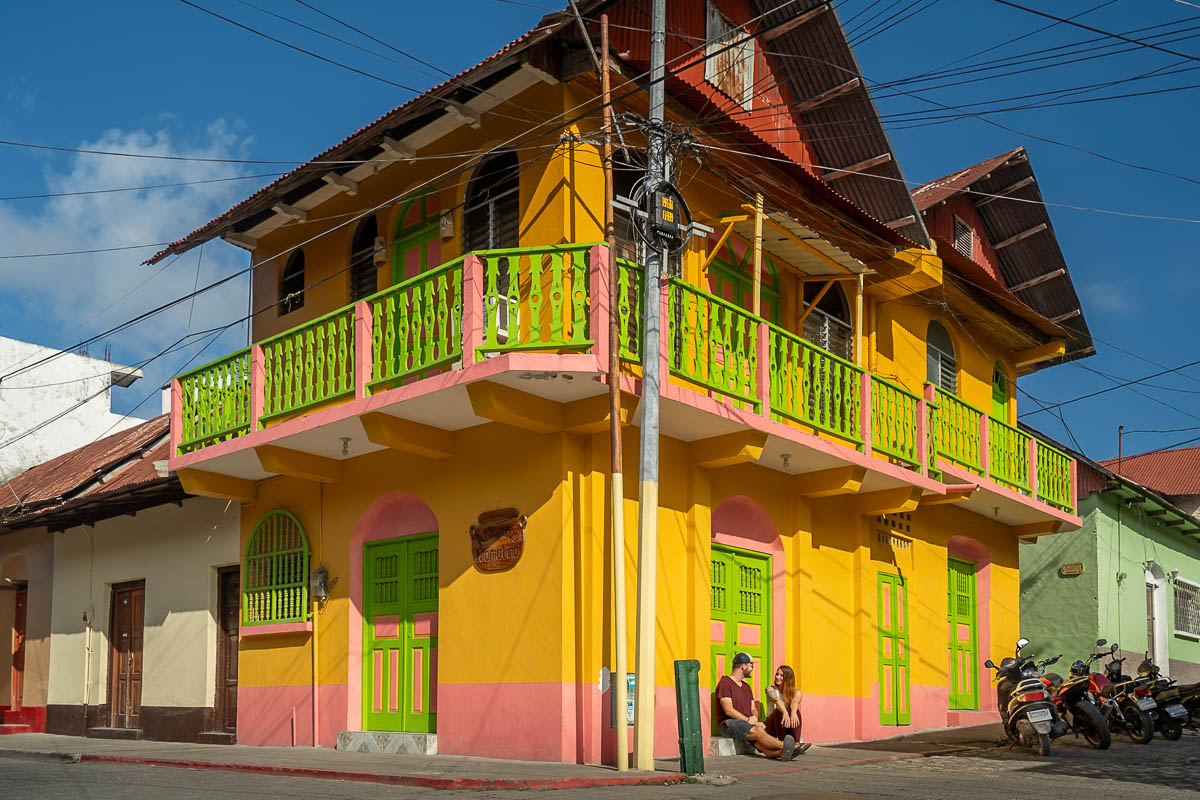
The most convenient locations for most visitors near Flores are likely in the Mundo Maya shopping mall across from the airport or this branch, near the bus terminal.
Like at the ticket office, you’ll need to purchase these in cash, but, luckily, almost all Banrural locations have an ATM. You will also need to show your passport in order to complete your purchase.
The bank will give you proof of purchase of your tickets, which you can show at the entry gate to Tikal.
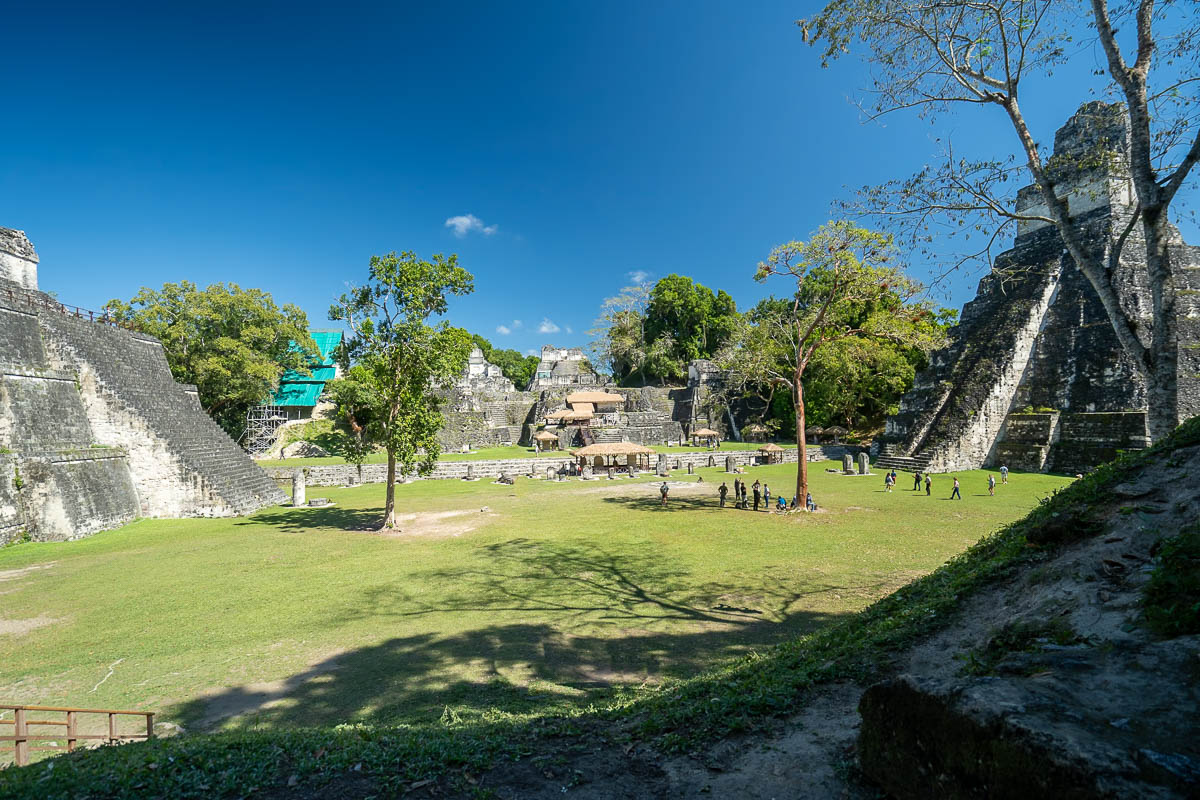
Be sure to check the hours each branch is open, because they can vary widely from store to store. I’d also suggest avoiding going around when the branch is supposed to open or close—unfortunately, Guatemalan businesses (even banks!) are not exactly known for their punctuality.
Online
As of 2023, you can purchase tickets online through Guatemala’s Ministry of Culture and Sports website.
You can either purchase tickets as a Guatemalan passport holder or as a foreigner.
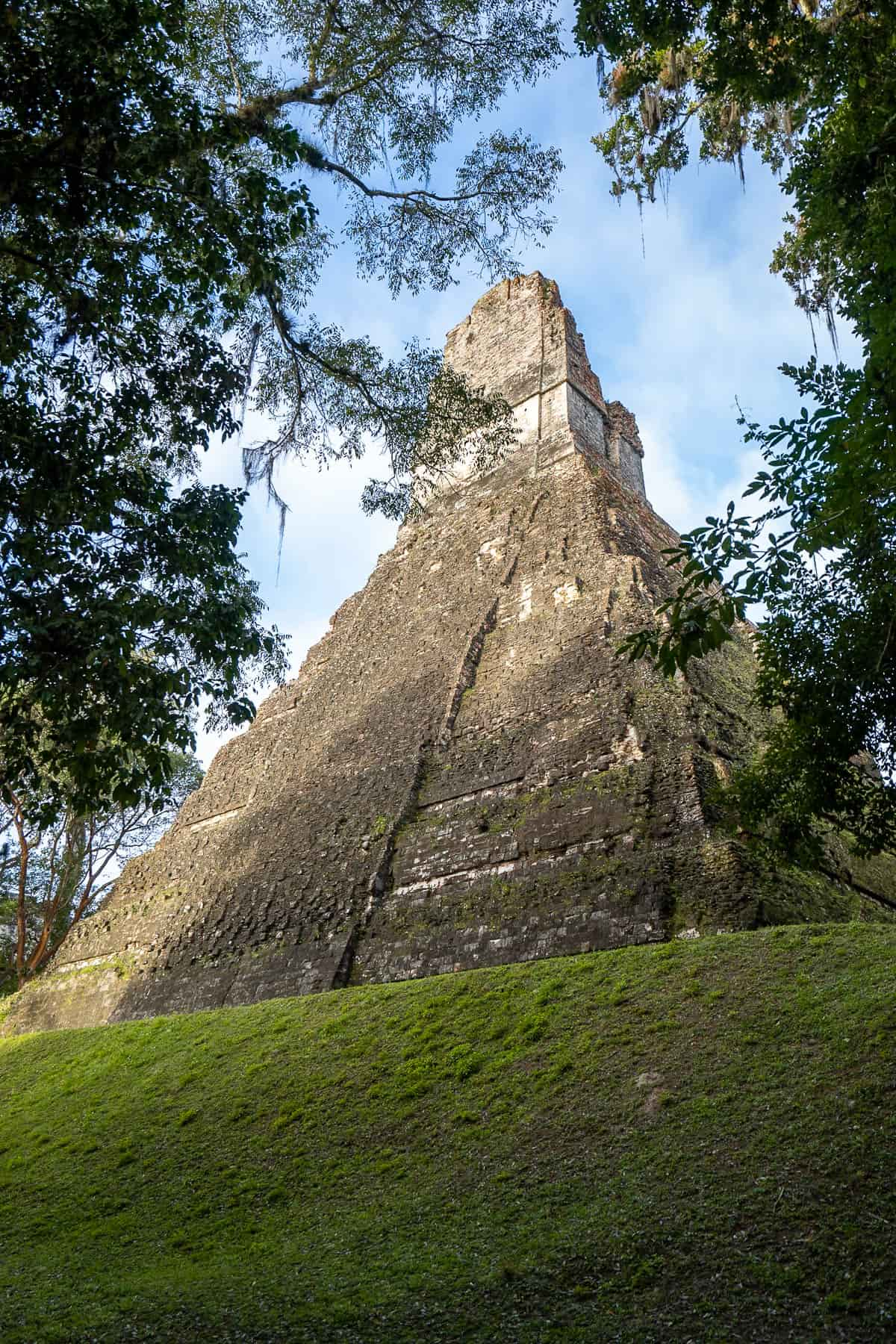
Guatemalans get a pretty steep discount here, but don’t try to purchase one if you don’t actually hold a passport from the country. They will absolutely check your passport here to confirm that you’re a Guatemalan national and make you buy another ticket (at full price!) if you’ve purchased the wrong ticket.
Assuming that you are not a holder of a Guatemala passport, there are several different ticket options, so be sure to purchase the correct one:
- Park entrance for foreigners (150Q), which every non-Guatemalan visitor will need to purchase
- Sunrise ticket (100Q), which is the supplemental fee you’d need to pay in addition to the park entrance fee, to see sunrise
- Sunset ticket (100Q), which is the supplemental fee you’d need to pay in addition to the park entrance fee, to see sunset
- Entrance to the museum (30Q), which gets you into two small museums that offer a closer look at smaller artifacts from Tikal, like vases, masks, or jewelry
- Entrance to Uaxactun (50Q), another impressive Mayan ruin site that’s connected to Tikal via a 12 mile (one-way) dirt road
- Entrance to the camping area (50Q), where you can actually camp overnight right outside of Tikal
The website has contradictory information, indicating on some pages that international credit and debit cards aren’t accepted and, on other pages, stating that they can be used but are subject to an additional 2.3% charge.
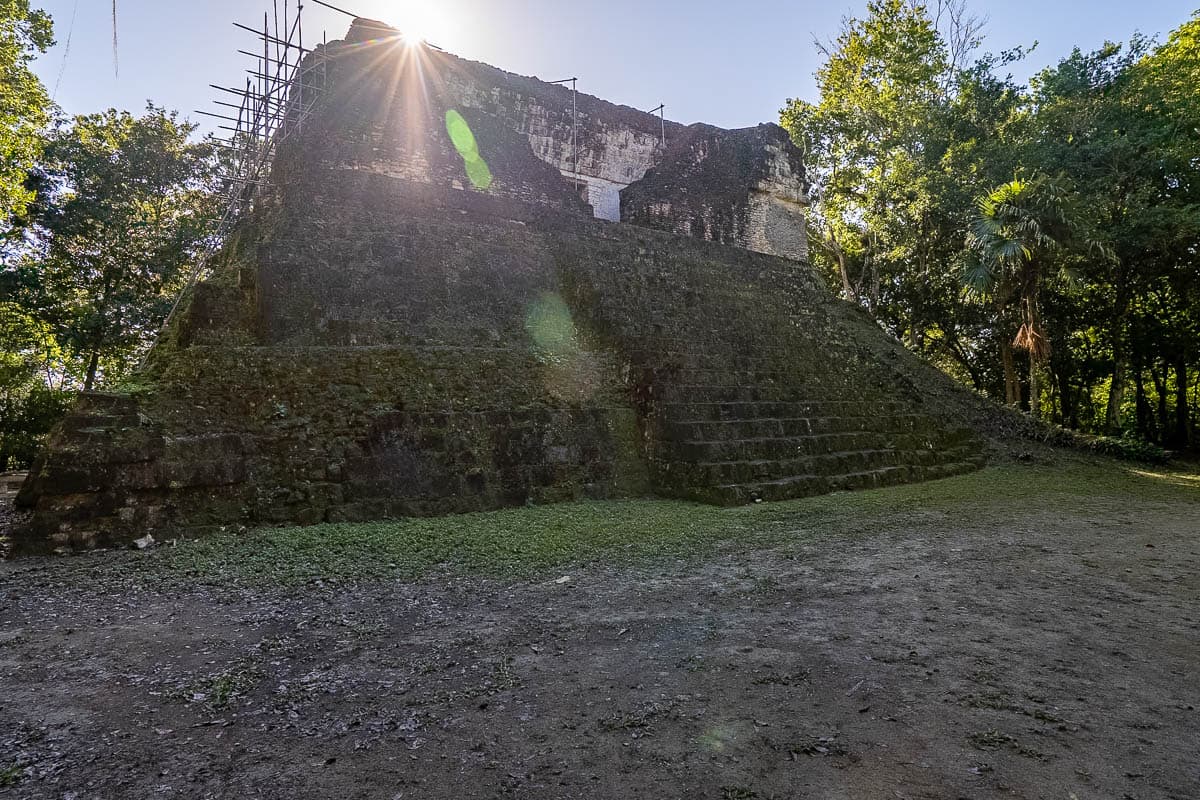
We used a foreign credit card just fine to purchase our tickets to Tikal. However, just in case it doesn’t work for you for some reason, I’d suggest trying to buy them at least a few days in advance in case you run into any issues and need to purchase them through some other avenue.
Insider tip: Once you purchase tickets, you’ll be emailed a receipt and a separate attachment, including your name and a QR code. You’ll need to either print or screenshot both of these documents before leaving Flores to show the attendants at Tikal—you will not have any cell service in the park and will likely not be able to pull up the documents from your email.
Do You Need to Go With a Guide While Visiting Tikal?
The answer is… it depends!
If you want to visit Tikal at sunrise or sunset, yes, you’ll need to go with a guide.
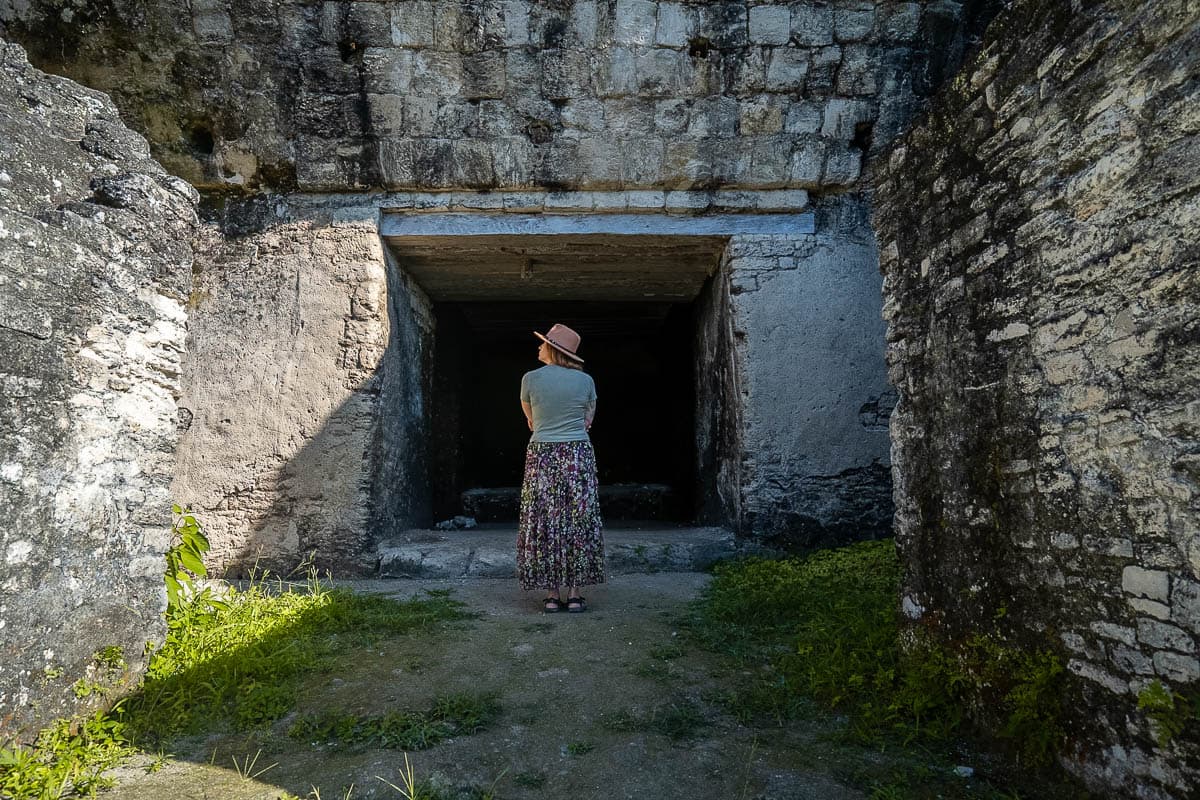
You can either go with a tour that you book online or in person at a tour agency or, alternatively, you can usually find a guide either outside of the Tikal entrance or at the Visitor Center (“Centro de Visitanate”). If you’re headed here for sunrise, though, I really wouldn’t recommend trying to find a guide at Tikal—it’s going to be extremely hard to find someone outside the park so early in the morning!
If you’re visiting the park during “normal” hours (6 AM to 5 PM), you do not need to go with a guide. However, they are definitely helpful to understand more about the history of Tikal and the people who lived there (there’s essentially no signage in the park) and to spot wildlife and the unique flora of this region.
Tips for Visiting Tikal
1. Arrive early or late
Tikal is at its beautiful when it’s at its most quiet, with nothing but the noise of the surrounding jungle. You’re most likely to get to experience the park like this before 11 AM or after 3 PM.
From the mid-morning through the early afternoon, the national park is usually bustling with dozens and dozens of tour groups—which can kinda kill the Indiana Jones vibes!
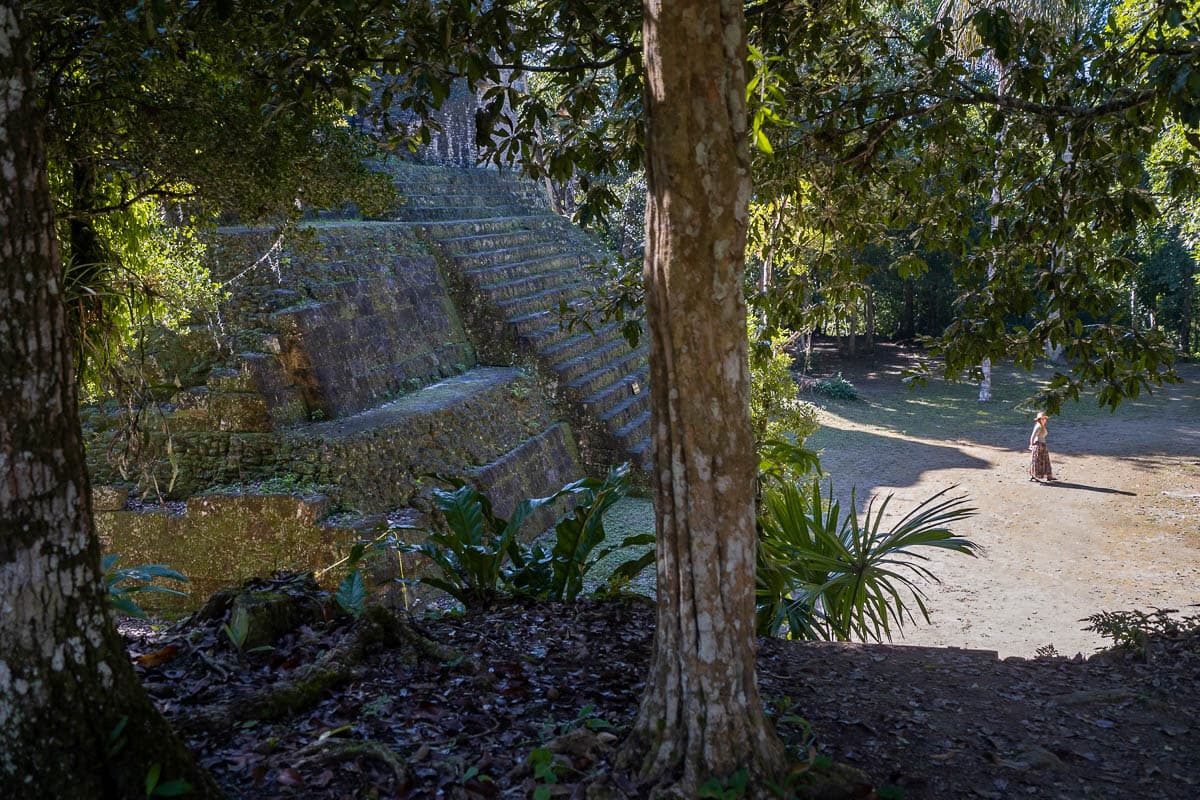
We visited Tikal from around 8 AM to 1 PM and were expecting it to get SUPER crowded as the day wore on. I’m not sure if it was just the time of year we visited (February) or the fact that we visited on a weekday, but it actually stayed relatively quiet throughout our visit, even in the late morning and early afternoon.
Still, if you’re hoping to get photos or videos of Tikal sans other people or want to soak in the animal calls from the jungle in relative peace, visiting outside of peak hours is definitely the move!
2. There are limited food and drinks available in the park
There’s only a handful of vendors that sell drinks and snacks, sprinkled throughout the park’s massive complex. There are also a handful of (overpriced) restaurants located near the entrance as well, but, given the park’s sprawling size, they’re definitely not the most convenient to walk to if you start feeling hangry mid-visit.
Accordingly, I’d suggest bringing along some food to enjoy on your bus ride to the park, so you arrive with a nice and full tummy.
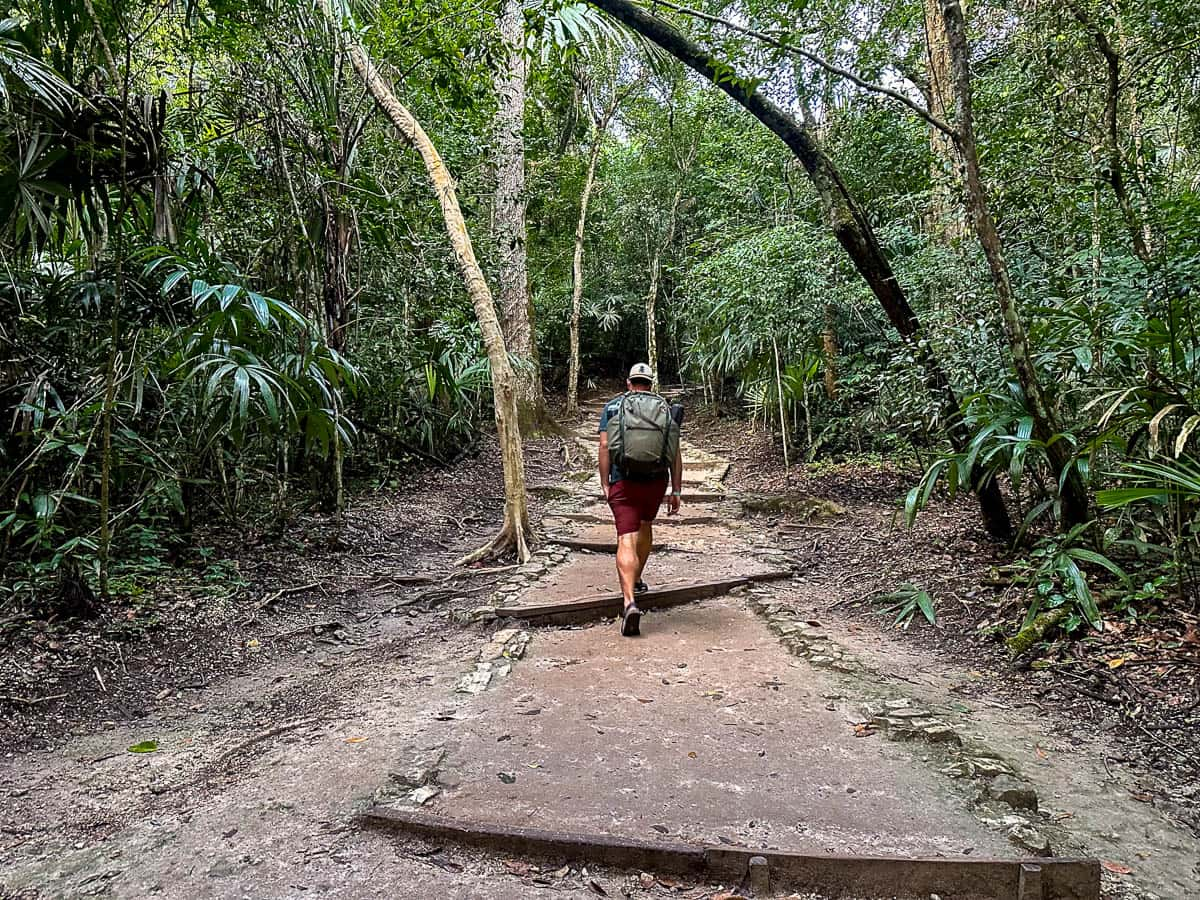
It’s also worth noting that our tour guide told us that bringing in outside food isn’t allowed in the park to prevent littering, but I can’t find confirmation that’s actually accurate anywhere online. So I’d suggest consuming any expensive snacks—or anything you don’t want to be forced to throw out—before passing through the entry gate, just in case!
Finally, Tikal is also the most hot and humid place that we visited in Guatemala, so be sure to bring along PLENTY of water. We made the mistake of assuming it would be easy to find vendors around the park and didn’t bring any—we wound up feeling super dehydrated and wasting a bunch of time wandering around to find some water.
3. Come prepared
There’s not a ton of things you need to bring with you to Tikal, but there are a few items that will make your visit that much more pleasant.
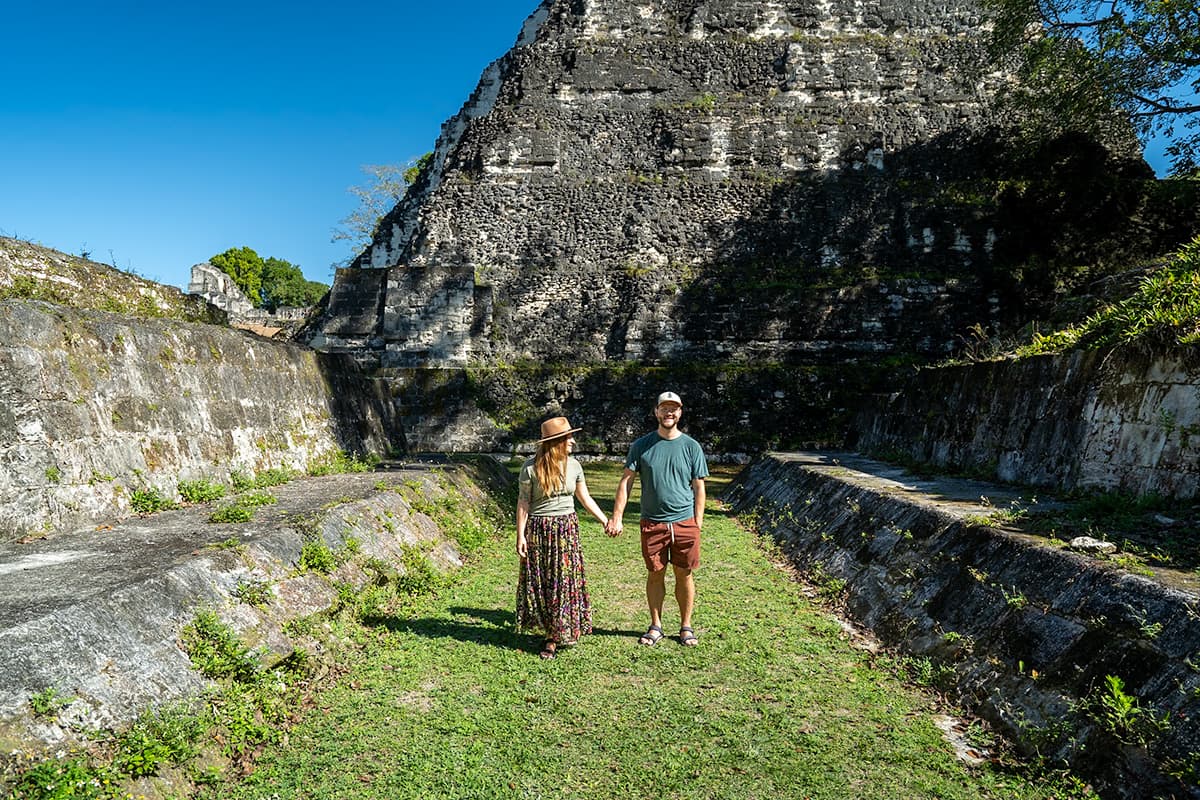
- Comfortable walking shoes: The number one thing I’d suggest bringing with you are shoes that you can walk miles and miles in. We walked over 25,000 steps the day that we visited Tikal, so this isn’t the day to bust out your high heels. I’d also suggest wearing shoes that have decent traction as some of the stone steps on the temples and ruins have been worn smooth over the millenia—so extra grip can definitely come in handy!
- Water: As mentioned above, Tikal can get super muggy and there isn’t a ton of water or other drinks that are readily accessible in the park.
- Sunscreen: A decent amount of the park is shaded by the dense jungle, but there’s also quite a bit that’s exposed to the sun.
- Bug spray: This is the jungle, y’all. There’s LOTS of mosquitoes.
- Rain jacket: Tikal is pretty rainy, receiving almost 44 inches of rain per year. You can mitigate your chances of encountering rain by visiting outside of the wet season (i.e., avoid May through November), but I’d still suggest throwing a rain jacket in your backpack, regardless of when you visit, just in case.
4. Don’t feed the wildlife
This isn’t specific to Tikal, but please refrain from giving any food to the wildlife here.
Unfortunately, people have fed the coatis (the racoon-like creatures you’ll see scurrying around) in the park, who now act, at times, downright aggressive towards humans to get food.
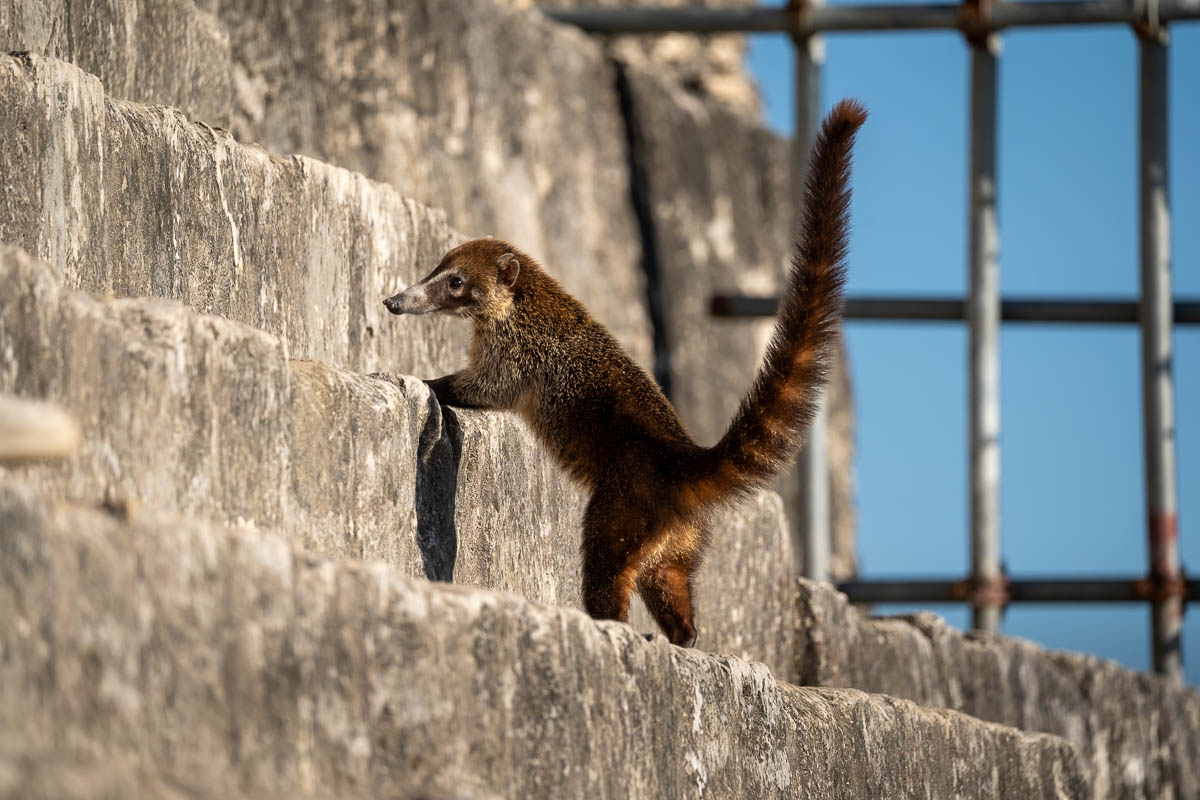
Even though tropical racoons are pretty darn cute, it’s not healthy for them to eat people’s food (and, frankly, it’s not too fun for humans when there’s overly *friendly* coatis everywhere!).
When to Visit Tikal
The best time to visit Tikal is during the dry season, from December through April, when the skies are clear and it’s not overly buggy.
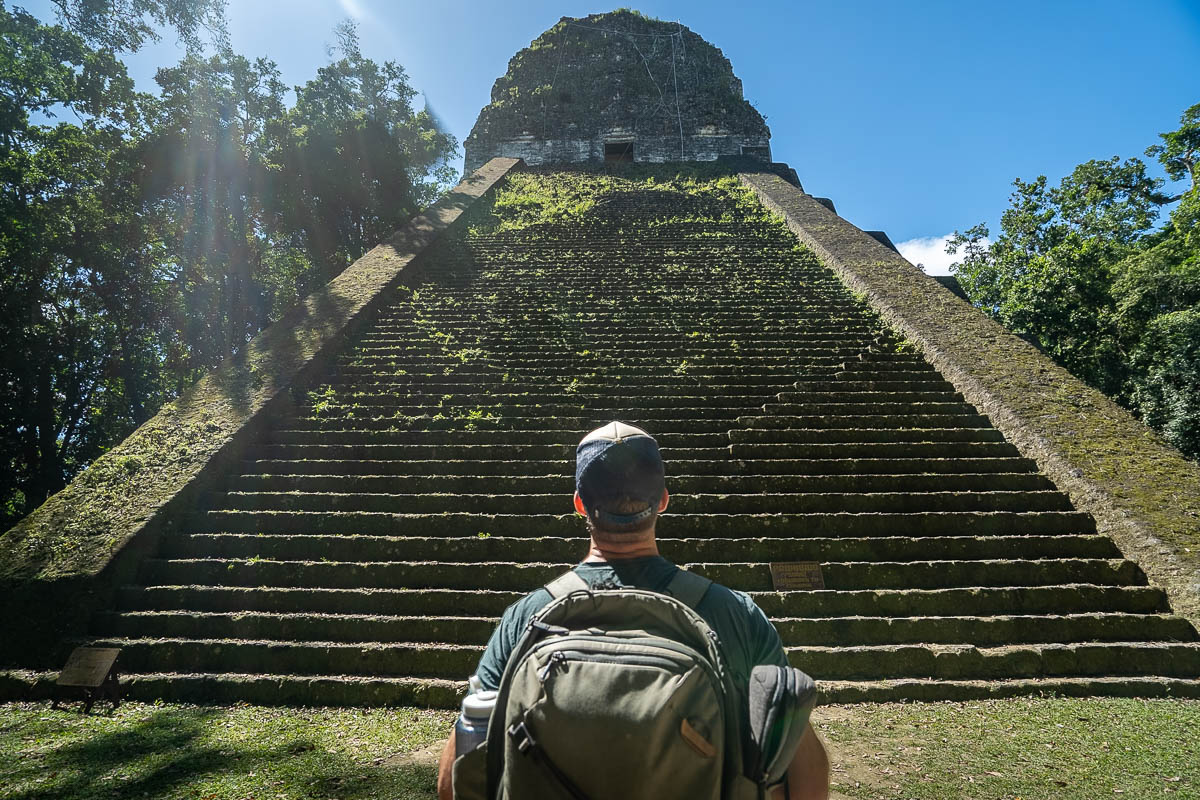
Visiting during the rainy season (May through November) is definitely not the greatest—exploring Tikal is an entirely outdoor activity (but for the tiny museums onsite), so it’s not exactly a great rainy day activity. Additionally, the stone steps and walkways of the temples can get quite slippery and dangerous when wet.
I’d also suggest trying to visit Tikal on a weekday. Weekends are a popular time for Guatemalans—who can enter the park at a steeply discounted rate—to visit, so it can get quite busy.
Best Things to See in Tikal
There’s over 3,000 buildings in Tikal so you probably won’t be able to see everything in one day.
During our visit, Justin and I walked through as much as the site as we possibly could, though, so here’s some of the most impressive sites in the park.
The Grand Plaza
This is the most well-known area of Tikal, with Temple I (or The Temple of the Grand Jaguar) and Temple II (or the Temple of the Masks) towering above the jungle below.
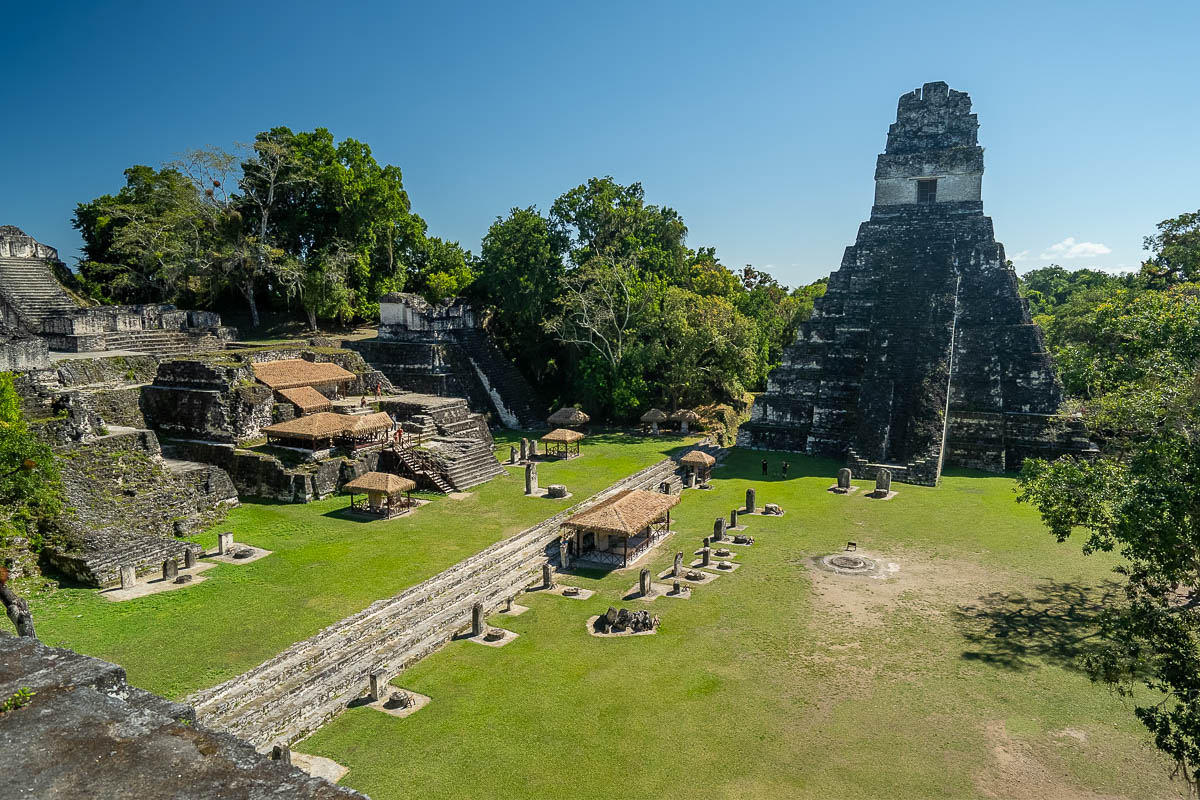
At 44 meters tall, Temple I is one of the tallest and is, inarguably, the most famous structure in all of Tikal. Unfortunately, though, you aren’t allowed to climb it.
You can, however, climb Temple II, which is directly opposite of Temple I and provides excellent vantage point of the surrounding ruins in the Grand Plaza.
Temple IV
As mentioned above, Temple IV is probably the second most famous pyramid in Tikal for a totally different reason—it was featured in the original Star Wars trilogy!
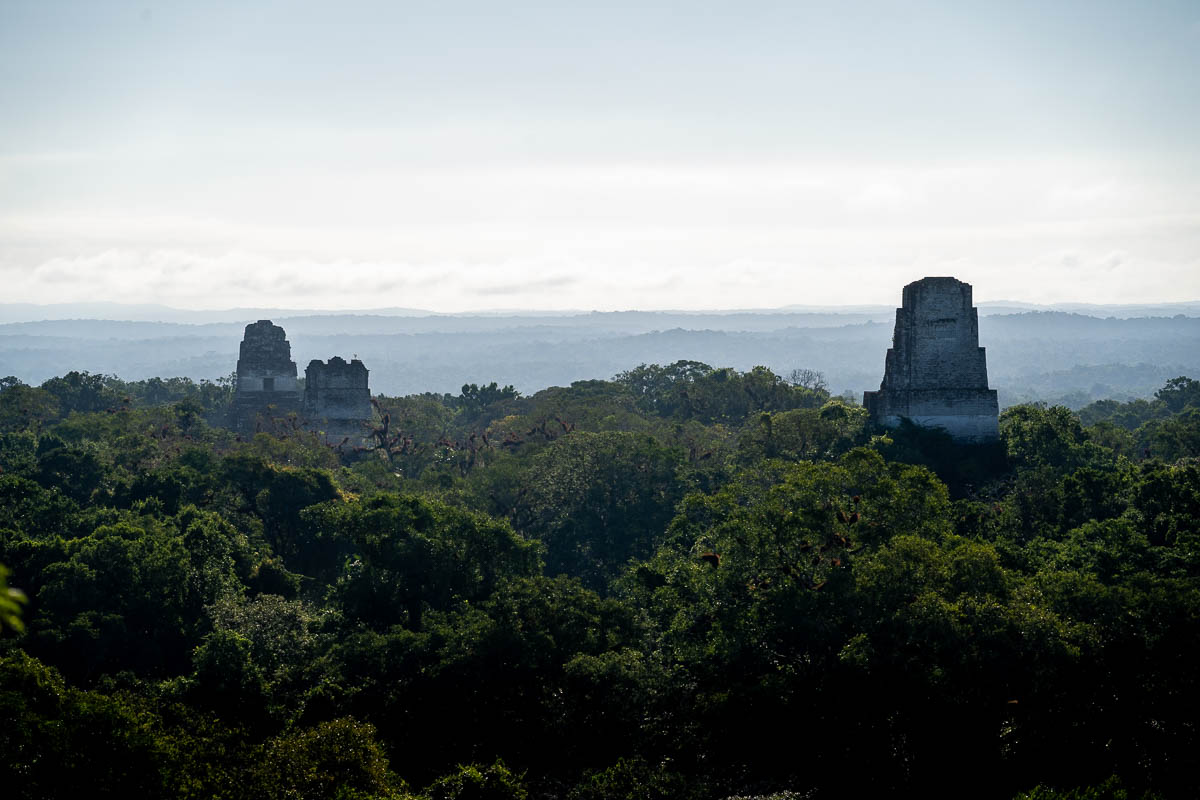
Whether or not you’re a fan of The Force, Temple IV is worth visiting, given it’s the tallest structure in the park AND you can climb it. After huffing and puffing your way up to its top, you’ll be rewarded with jaw-dropping views of the surrounding pyramids and the Guatemalan jungle.
Temple V
Temple V, a moss-covered pyramid, is the second tallest structure in the park, at 57 meters tall.
Additionally, this impressive temple is tucked away in its own little corner, near the Grand Plaza. Because of its more secluded location, you have a good chance of getting to admire this impressive pyramid by yourself!
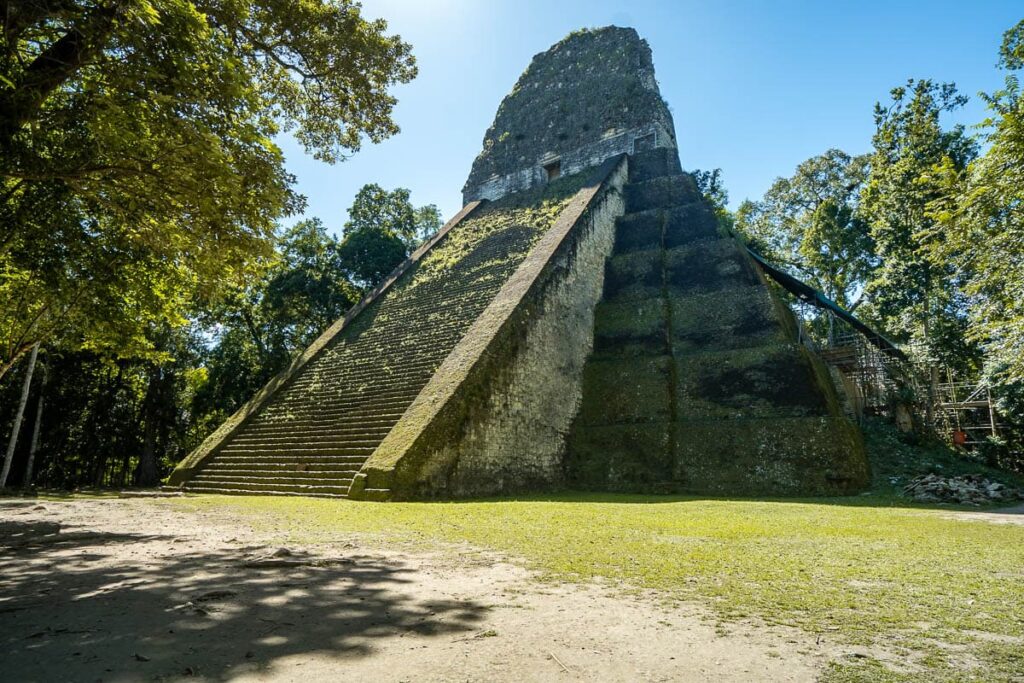
Complex P
As for some of the more underrated gems of Tikal, we LOVED Complex P, a cluster of ruins that are hidden deep in the jungle of the southeastern side of the park.
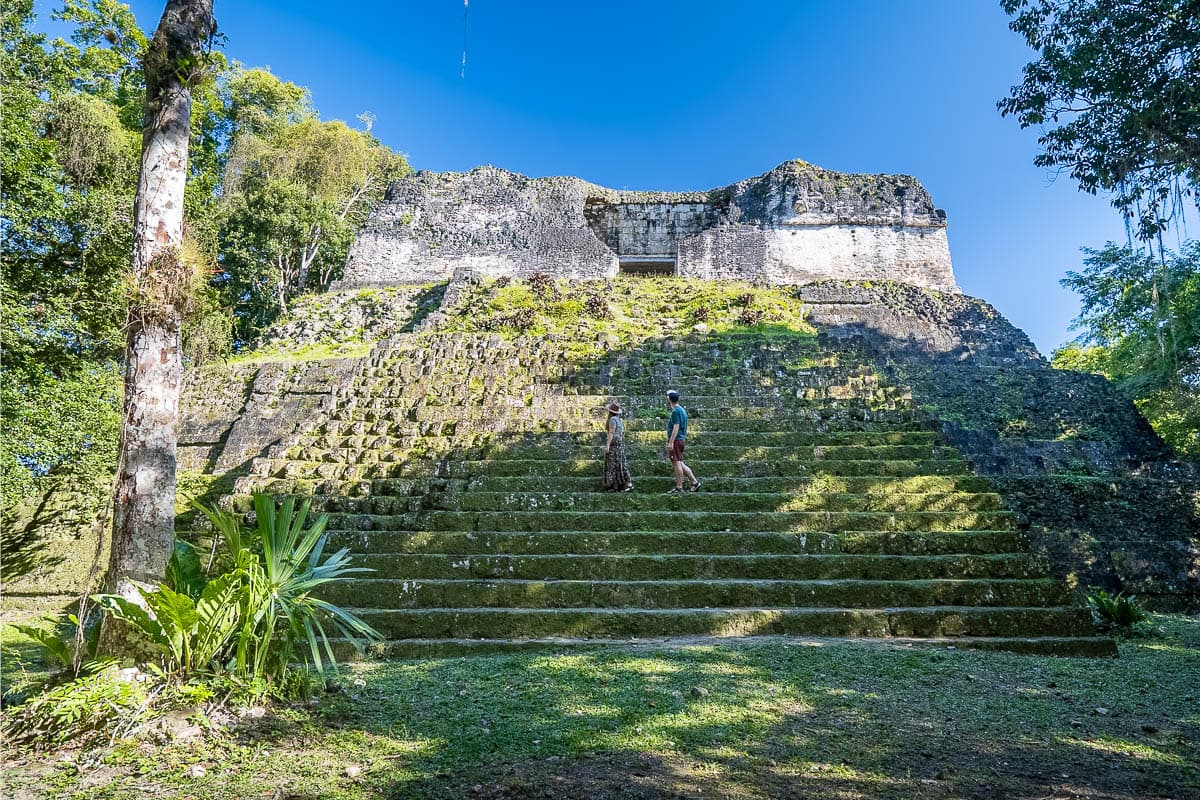
Not only is there a beautiful pyramid you can climb up, but there’s actually some open rooms at the top for you to poke around. We had this corner of Tikal all to ourselves for at least half an hour, so the Indiana Jones vibes are definitely high here!
Mundo Perdido
Found at the northern end of the park, Mundo Perdido (or “The Lost World”) is aptly named—most visitors skip the moss-covered ruins in this more remote section of the park.
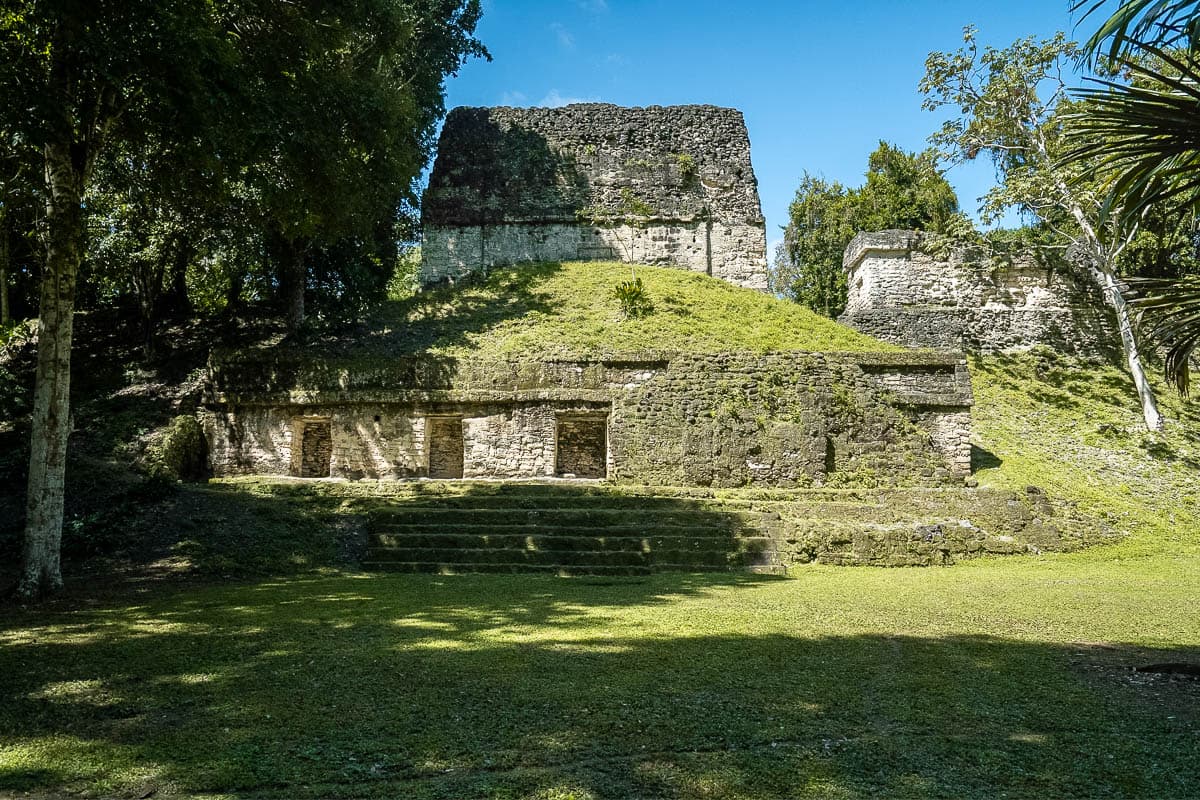
But that’s a huge mistake—you can actually climb up the Great Pyramid here, which is the oldest structure in the park and provides great views of Pyramids I, II, and III off in the distance.
Where to stay when visiting Tikal
You’ve got a few options of where to stay when visiting Tikal.
Regardless of where you stay, I’d suggest booking accommodations around Tikal early—they’re definitely on the more limited end of the spectrum and can sell out surprisingly far in advance (especially with respect to options on the more affordable side!).
Hotels in Tikal
One of the coolest things that many visitors don’t know is that you can actually stay RIGHT outside of the entrance gates of Tikal, which enables you to be immersed in the dense Guatemalan jungle and makes it much easier to enjoy the enormous site at your own pace.
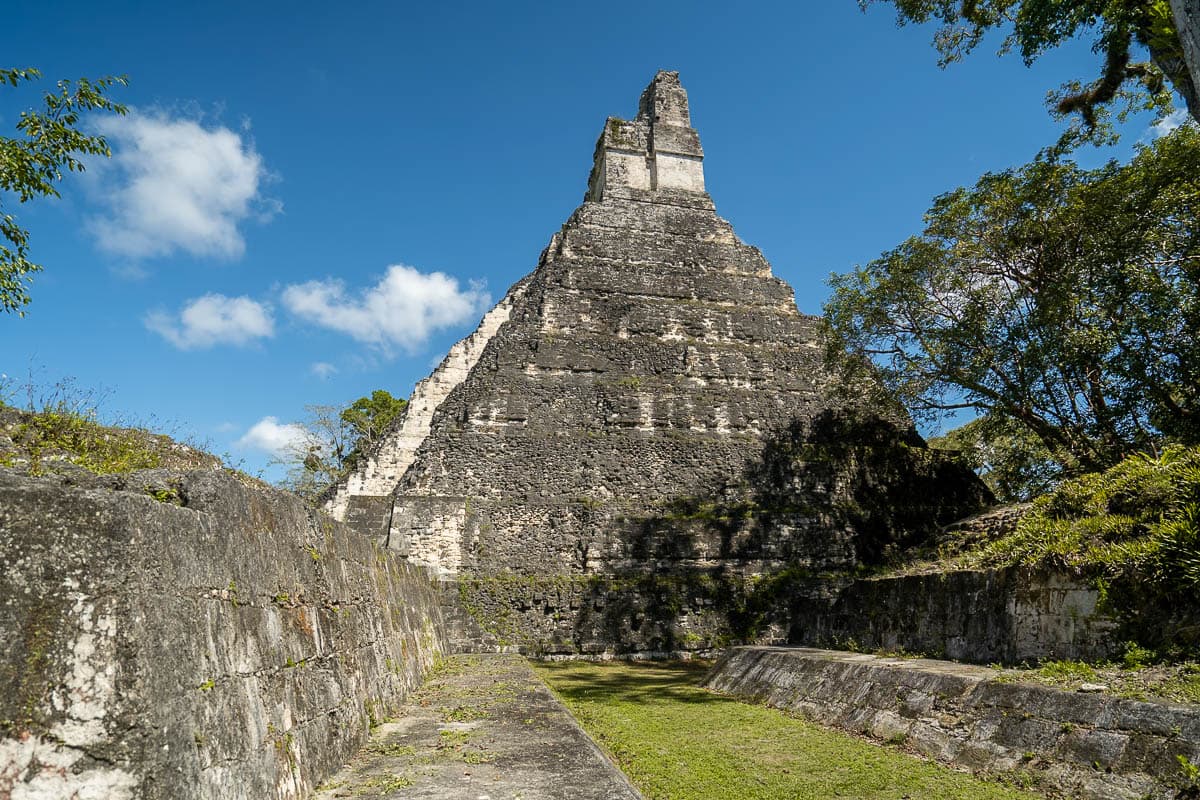
There’s only a handful of hotels to choose from here, but the best are:
- Hotel Tikal Inn: This is the nicest place to stay in Tikal, with a nice pool to cool off in and watch the monkeys play overhead. The rooms are in rustic thatched roof cottages, but are spacious, comfortable, and offer everything you’d need during your stay in Tikal.
- Jungle Lodge Hotel: If you can look past some of the slightly dated aspects of this hotel, there’s a lot to love about this hotel, including a nice pool, a surprisingly delicious breakfast, and an unbeatable location.
- Jungle Lodge Hostel: This hostel has some pretty cool history—it’s actually where some of the first archaeologists to excavate Tikal stayed in the 1950s. Of all of the hotels in Tikal, this one is the most basic, with shared bathrooms, but it still offers an incredible location right outside of the park’s entrance and has other nice perks, like a pool, vibey bar, and friendly staff.
Camping in Tikal
Did you know you can actually camp in Tikal?
There’s actually a campground right outside of the entrance of Tikal, which costs 50Q per person to stay at that can be purchased online. Additionally, you can rent tents (with very basic mats inside) for 70Q or a hammock for 50Q per night directly from the campground.
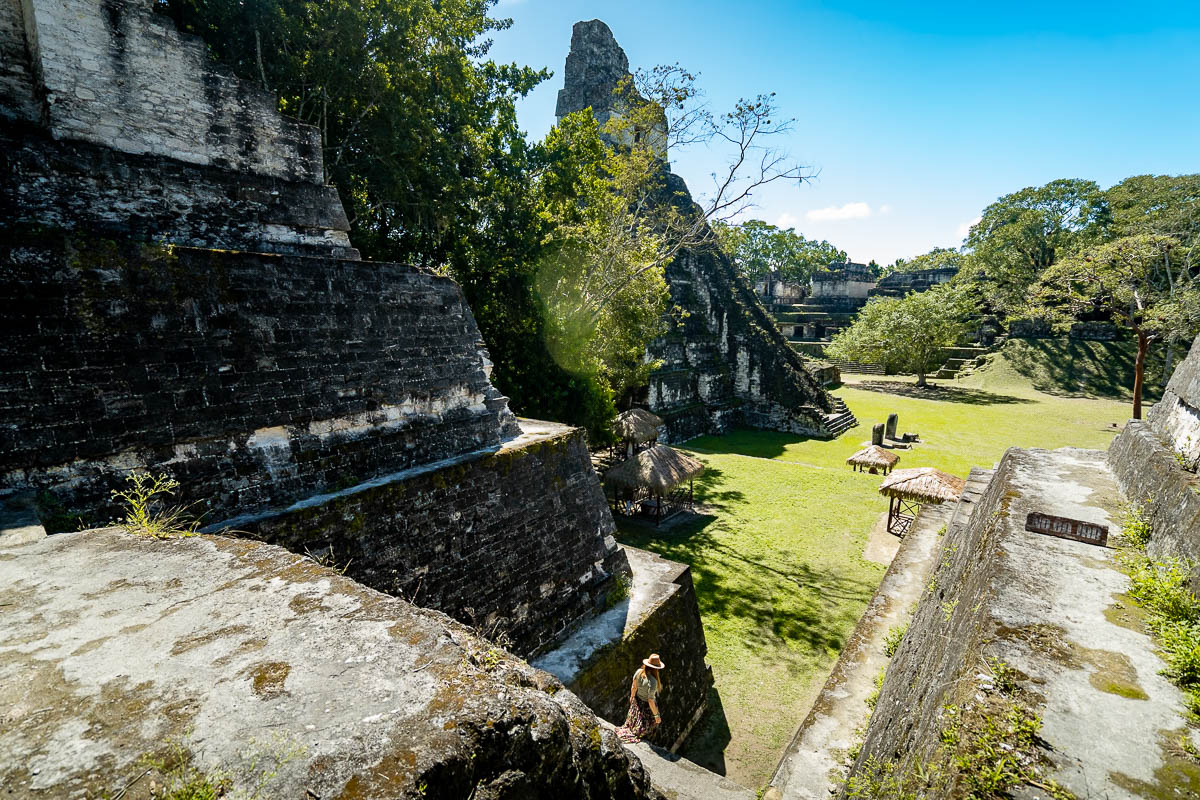
Justin and I had actually planned on camping in Tikal—how cool would it be to listen to the sounds of the jungle around you as you fall asleep?!—but, after two weeks of sprinting through Guatemala, decided to opt for a hotel room instead. But this is definitely on the bucket list for next time we’re in Guatemala!
Stay in Flores
Most visitors opt to stay in Flores and visit Tikal as a daytrip. There’s tons of hotels to choose from in Flores, including:
- Hotel Isla de Flores: This is, by far, our favorite hotel in Flores, with comfortable and stylish rooms with air conditioning, a cute little pool area, and a really nice rooftop bar. The restaurant on the ground floor is SO cute and has killer pastries—even if you don’t stay here, it’s worth popping in!
- Los Amigos Hostel: If you’re looking for more of a hostel-vibe, Los Amigos is definitely the place in Flores, with a funky, jungle-y interior; social atmosphere; and excellent location in the heart of Flores.
- Hotel Casa Amelia: This hotel has rooms directly overlooking Lake Peten, with air conditioning and huge comfy beds. It is a bit on the noisier side, due to the party boats that sail past it at night, so this one might not be for the lighter sleepers.
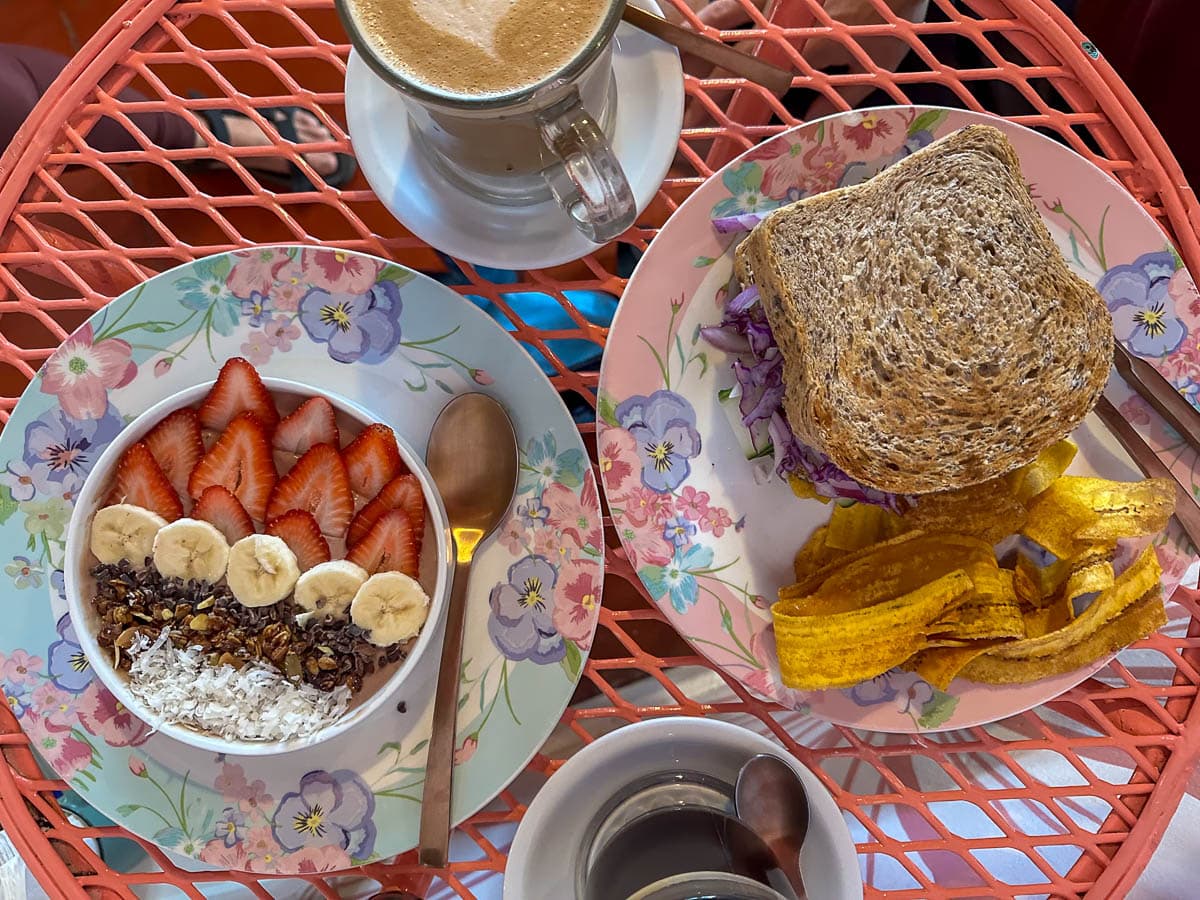
Have the BEST time exploring Tikal—it’s such a magical place to step back into history. Do you have any questions about visiting the national park? Let us know in the comments below!

